The Science of Laughter
This week, the Naked Scientists take a look at the science of laughter, asking when and why laughter first began, hearing what babies find hilarious and meeting a joke-building robot. Plus, in the news: a gene editing technique takes on a deadly disease and scientists tie the world's tiniest knot.
In this episode
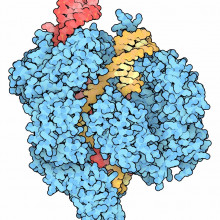
00:50 - Gene editing fixes immune deficiency disease
Gene editing fixes immune deficiency disease
with Harry Malech, National Institutes of Health
This week, scientists in the US have taken the first steps towards fixing a genetic defect that leads to an inherited immune problem which is called chronic granulomatous disease and leaves sufferers prone to serious infections. The team at the NIH have used a DNA editing technique called CRISPR to correct a mistake in a gene that arms immune cells so they can kill bacteria and other infections. The team are doing it on bone marrow stem cells that produce immune cells that then circulate in the blood. The idea is to fix a patient’s own cells safely in a dish and then return them to the patient. Harry Malech explained the process to Chris Smith...
Harry - For most of my career I’ve been interested in an immune deficiency called chronic granulomatous disease. Patients with this suffer from recurrent infections because they’re circulating white blood cells, called neutrophils, fails to produce hydrogen peroxide. And it’s used by these cells that engulf microorganisms to kill those microorganisms that if you don’t have the hydrogen peroxide then the cells can’t do their job and that’s why the patients suffer from recurrent severe infections. They get pneumonias, they get infections of their bones, they can get liver abscesses and so our goal is to find a way to fix them.
Chris - Why do they have that condition? What’s the underlying process that leads to them lacking this natural hydrogen peroxide disinfectant?
Harry - This is an inherited problem. The majority of patients have a mutation in a gene carried on the X chromosome. One treatment is bone marrow transplant which can cure the disorder, but because it involves collecting cells from another person, those cells may see the new host as foreign and, therefore, one can get high risk from this disease from graft versus host disease. But knowing that a transplant can cure means that if we take the patient's own cells and fix them, we might have the same outcome but without the graft versus host disease.
Chris - So talk us through what you are actually doing then. Which cells are you working with and how are you manipulating them?
Harry - Most of our patients, we are able to treat them in a way that makes the stem cells come out of the marrow and circulate in the blood, which we collect using a large blood centrifuge, and then we use gene editing techniques to fix the mutation that’s in those cells.
Chris - And when you do this, what fraction of the cells that you started with actually get fixed?
Harry - We’re pretty excited by that fact that we’ve been able to reach somewhere in the range of 25 to 30 percent of cells being fixed in the dish. However, the critical cells are the small subset of those cells that are able to go back into a patient and then graft long term. And our other studies in mice show us that we probably get into about 10 to 20 percent of the long term cells that can restore marrow.
Chris - And having fixed at least a proportion of cells in the dish, is the goal that you will put those cells back into the person having ascertained they’re safe, of course, so that they would go back to the bone marrow and then act as long-term, long-lived supply of healthy immune cells so the patient would have enough healthy cells in order to fight off infections?
Harry - I actually don’t need to repeat what you’ve said because you are exactly correct. The goal here is that if you don’t hold these cells too long in the culture, they retain their ability to re-engraft in the patient they came from. And if you’ve now got fully corrected cells, they are able to serve as long-term, maybe even the life of the patient, to make neutrophils that now can produce the hydrogen peroxide.
Chris - Do you have any evidence that that can be achieved? Have you done the experiment where you’ve taken the cells and put them back into, admittedly not a person, but something resembling a person i.e. a mouse to see if they’re capable of doing that?
Harry - There’s a very helpful mouse model such that these mice have some defects in their immune system which allow human stem cells to be engrafted in the mice. So, from the point of view of the mouse’s marrow, it’s like a little mouse person and one can actually follow these mice out for, in the case of the paper, we followed them out for five months. That’s a long time, certainly not the lifetime of a person, but long enough for us to say with some certainty that we have corrected the long-term engrafting cells that could fix patients if we actually took these and engrafted them back into people.
Chris - Now what about the safety side of this though? Because it’s quite an unnatural experience for these cells to be in a dish, to have their DNA edited and then to go back into a person again. What are the risks and how sure are you that we haven’t introduced other changes into those cell’s DNA so they could, for instance, spawn blood cancers?
Harry - You raise one of the key safety points that many in the field, including our FDA and other regulatory agencies, are concerned about. In the paper we describe a number of sophisticated ways in which we look to see if we’ve made changes in other places in the genome. At this first pass, it looks as if we haven’t made detectable changes at other places in the genome. We believe, however, that before we were to actually do this in patients that we need to do more work in that area, both to satisfy ourselves, and to satisfy the regulatory agencies that we’ve made no untoward changes in other places in the genome.

06:41 - Scientists tie the nano-knot
Scientists tie the nano-knot
with David Leigh, University of Manchester
What do a clove hitch, a sheet bend and a sheepshank all have in common? They are of course, as any former scout will tell you, all knots. But I bet they couldn’t tie an 819 knot: at less than a millionth of a millimetre across, it’s the world’s smallest knot and it’s just been tied by a team at the University of Manchester. They made the molecular tangle in a test tube using a sequence of carefully-controlled chemical reactions that used iron catalysts to bend and entwine short strings of carbon-rich molecules. Tom Crawford heard how from lead author David Leigh...
David - What my group’s done is tied the smallest, tightest knot that’s been tied to date. So the knot has eight crossings in 192 atom strand and that makes it the tightest knotted physical structure ever made.
Tom - How small is this thing?
David - The width of the molecular strand is just half a nanometer, so that’s less than a millionth of a millimeter. So that’s ten thousand times thinner than a human hair. And the length of the molecular strand if it was opened out is just 20 nanometers, so that’s five hundred times smaller than a red blood cell, one of the smallest cells in the body.
Tom - Wow! Tiny then?
David - Very, very small indeed - yeah.
Tom - And when you say a knot, do you mean like me tying my shoelace, or like a fisherman’s knot?
David - Yeah, it’s exactly the same principle, but in mathematics a knot actually describes a closed loop. So this is exactly like the sorts of knots that you would tie in your shoelace or a fisherman would tie except it’s got no end, so the ends have been fused together.
Tom - So, if I tied my shoelace as I normally do and then the two straight bits that are left, if they were fused together?
David - Yeah, if you just glued those together then you’d get what a mathematician would call a closed knot.
Tom - What does the knot actually look like?
David - Obviously it’s too small to see; it’s very tiny. But if you use a technique to look at the positions of the atoms, which we can do very precisely with a technique called X-ray crystallography, you can see that it looks a little bit like a four leaf clover with the strands wrapping round the outside of the leaves of the four leaf clover, and then they cross over and under each other eight times.
Tom - That leads me quite nicely in the next question actually - how did you make these knots?
David - You can’t simply tie molecular strands in the same sort of way that you would tie a strand in the big world into a knot, they’re just too small to grab hold of the ends. So what we use is a technique called self-assembly in which the molecular strands are woven around metal ions. The metal ions are sticky in certain places and positions of the ions and the strands, the building blocks, wrap around those in a precise way forming the crossing points in the right places, just like happens in knitting. Then once all the pieces are assembled in the the right way, then we use a chemical catalyst to fuse the ends of those strands together to close the loop and form the completed knot.
Tom - So now that you’ve made this knot, what uses do you see for it going forwards?
David - Knotting, of course, is also a very similar process to weaving. And so it should be possible for us to use the same techniques that we’ve used for knotting molecules to actually weave molecular strands, and in that way we hope to make strong, flexible, light materials out of molecular strands.
Tom - How does weaving lead to stronger materials, for example?
David - The benefits of weaving fabrics we can see in our big world, of course, mankind has been doing it ever since we moved out of caves and used knotting and weaving for making fabric, but also for making tools and materials. It allows fabrics to stretch in different directions, to hold their shape and to be light and strong and flexible. And examples of where this might be useful - weaving on a molecular level might be say kevlar, which is a type of super-strong plastic which is used in bulletproof vests and knife-proof body armour. Kevlars chemical structure is, basically, a whole lot of tiny straight rods that pack very closely together - a bit like pencils stuffed tightly in a pencil box. What we may be able to do is actually weave strands of materials instead of having things that are packed closely together and maybe that will lead to lighter, stronger, and more flexible materials than having them all packed tightly together like they currently are.

12:05 - Walking for well-being
Walking for well-being
with Dr Chris Power, University of York
A new prototype app for smartphones has been made aiming to help older people get out of the house, and go on walks. It’s called ‘Walking for Wellbeing’ and aims to combat the growing numbers of people who find it tricky to get around. Georgia Mills spoke to the University of York’s Dr Chris Power, who was technical lead on the app…
Chris - We do know from reports, such as those that are highlighted on the ‘campaign for loneliness’ that over 51 percent of people do live alone over the age of 75, and that 59 percent of adults that are aged over 52, they report bad health. We know from the work that we’ve done on the project that if you perceive yourself to have bad health, that’s going to prevent you from wanting to undertake the physical activity which will then initiate a cycle of loneliness that’s going to happen in isolation.
So what we want to do as opposed to looking at fitness and trying to drive people out to be more fit, we want to try to encourage them to overcome those things that they may be perceiving as stopping them. So things like perceived barriers in the environment, looking at uneven pavements and other obstructions to their journeys will keep them from getting out. So what we’re trying to do is look at an app that would help people get out from the house and plan journeys that would help them encounter those things that would help them, but avoid some of those obstructions.
Georgia - Okay. So how is the app going to work?
Chris - The app works by having people input a set of preferences regarding things that they would be interested in encountering, so things like heritage or nature, as well as things that they like to avoid. So things like uneven pavements or slippery surfaces, or places where people might park bikes in pedestrian walkways for example, or cars overlapping where they would park on the road. The app has preferences attached to all of those things and it will pull information from the environment. We’re looking at things like open street map and other open-link data sources where we could pull information regarding, for example, bus stops or places that particular shops are, and possibly some crowdsource data.
Then the app will plan particular routes that will take people to those things that they want to see but avoiding those things that they don’t. And this could be either just getting out for a walk or it could be trying to undertake some sort of task like going out to the post office or going out shopping.
Georgia - The demographic this is aimed at is the elderly, but isn’t this also the same demographic the least likely to own a phone and have apps?
Chris - Well that’s certainly changing. So when you look at things like the OfCom report in 2015, we actually find that between 2012 and 2015 there was an increase to over 50 percent uptake of smartphones, and that’s something that is a big change that’s happening. We know from a Deloitte report in 2016 that for people over 55, over 60 percent of them also have a tablet, so we’re certainly seeing those demographics change. Certainly for the’ baby boom’ generation, or as some of my colleagues like to say the ‘rock and roll’ generation, it’s definitely the case that they’re having major uptake of mobile technology.
Georgia - And where are you with this app - when are you hoping to have it rolling out to the public?
Chris - So currently, right now, we’re in a prototype stage. We’ve done a large number of iterations on the prototype and we’re pretty confident that the journeys we’ve designed are solid. We’ve had good feedback in evaluation sessions from our users but right now we don’t have the backend technology implemented. So it’s probably looking at another round of funding to try to get this moved to market and we’re investigating follow-up funding with RCUK and also with INNOVATE UK, possibly looking at venture capital for a spin out in order to be able to get this app to market.
Georgia - I suppose you’ve got to be careful when you do something like this that you don't direct people into a quarry or something like that. You need to get it right first time.
Chris - Exactly. There’s a number of different things we have to look at and one of things such as safety, and documenting the different risks that might come along are really, really important. We wouldn’t want to rush this out.

15:49 - Mythconception: Do antioxidants really keep you young?
Mythconception: Do antioxidants really keep you young?
with Thomas Crawford, The Naked Scientists
In this week's myth, Tom Crawford questions his choice of new year resolution as he investigates the science behind the infamous ‘free-radicals’ and their sworn enemy, the all-conquering antioxidants…
Tom - We’re now well into the new year - how are those resolutions going? If, like me, you’ve decided to eat more healthily, maybe you’ve been stuffing yourself with antioxidants. They’re good for you… right? And they attack free radicals, those naughty things flying around in your body causing damage to your cells and making you age faster. At least that’s what we’re told by the so-called ‘health experts’. Let’s see what science has to say on the subject…
The story begins in 1945, when the wife of chemist Denham Harman suggested that he read an article in Ladies Home Journal entitled “Tomorrow you may be younger.” This sparked his interest in the process of aging and a few years later whilst working at the University of California, Berkeley, he proposed that ageing is caused by reactive molecules that build up in the body as byproducts of your body’s natural processes and lead to cellular damage. These are what he called “free radicals.” Harman himself described his discovery as ‘a thought out of the blue.’
Scientists began to rally around the theory of free radical ageing and that antioxidants such as vitamin C and beta-carotene were able to neutralise them. The antioxidant boom occurred in the 1990’s with the word entering into the public domain and supplements being added to foods and taken as tablets. It wasn’t until the early 2000’s, however, that scientists began testing the theory and they encountered some interesting results. Two separate studies compared mice, which were genetically engineered to overproduce either free radicals or antioxidants, with normal mice and they saw no change in the life span in each case. Further studies in humans found antioxidant supplements negate the health promoting effects of exercise and may even lead to a higher chance of death.
The increase in life expectancy which is often attributed to antioxidants is, in fact, likely to be a byproduct of a generally healthier lifestyle. People that take antioxidant supplements tend to be more health conscious in general and as a result, are likely to live longer.
The bottom line is that scientists are still unsure of the exact roles of free radicals and antioxidants in the body and more studies are required. Most researchers do agree, however, that free radicals cause cellular damage but this is not necessarily a bad thing. In many cases is seems to be a normal part of the body’s reaction to stress. We are certainly not being oxidised and therefore do not require antioxidants to save us from impending doom as the health experts would like us to believe.
Nonetheless, the global antioxidant market was worth 2.1 billion dollars in 2013 and is expected to continue to grow by a further billion by 2020. I’ll leave you with a quote from Professor David Gems from University College London, which sums it all up quite nicely - “It’s a massive racket. The reason the notion of oxidation and ageing hangs around is because it is perpetuated by people making money out of it.”

19:20 - Does sci-fi need to be accurate?
Does sci-fi need to be accurate?
with David Kirby, University of Manchester, Sara Kenney, Surgeon-X
Scientific inaccuracies in film and fiction: artistic licence or a serious problem? Liam Messin has been finding out…
Liam - do you get annoyed when Hollywood gets science wrong? Well our followers on Twitter certainly do:
Any film that has sound in space because, in space, nobody can hear you scream.
The plot of 2012 relies entirely on the phrase “the neutrinos are mutating.”
When a power surge causes all the fuses to blow.
I find radiation in films is rarely portrayed accurately. It generally seems to fill in as - insert nebulous evil sounding sciency thing here. And that tends to be the thing that bugs me the most with films about science because I suspect it further colours people’s opinion of anything labelled nuclear, or involving radiation in reality.
Liam - Some of our listeners there. The last of which raises an interesting point - can inaccuracies be damaging? I spoke to David Kirby, a senior lecturers in science communication studies at the University of Manchester, and asked him if movie mistakes can be harmful?
David - Yeah well. If you think about let’s say health, medicine, or genetics. Having something that inaccurate is a problem because it can affect the way in which people approach decisions about their health. So, for example, the ways in which comas are depicted in movies, that’s been shown to have an impact on ways in which people think about the notion of a coma - how long it goes on, what’s your chances of actually recovering...
Liam - Should we then be making our fiction as scientifically accurate as possible? Meet Wellcome Trust funded comic book writer Sara Kenney. Her latest project “Surgeon X” is set in a world in which the antibiotic apocalypse we’ve been be fearing has indeed come to pass, and bacterial infections are no longer treatable. I asked Sara to tell me exactly what is Surgeon X?
Sara - First and foremost it’s a comic book, and it’s a comic book that’s set about 20 years in the future in London in the midst of an antibiotic apocalypse. It’s also an app, and on the app you can read the comic, but on certain panels you can click on the speech balloon and you’ll have interviews from experts who’ll tell you a bit more. We’re calling it “behind the scenes speech balloons.”
Liam - What do you mean by an expert - a comic book expert?
Sara - It’s set in a medical future so we have surgeons, microbiologists. We have, obviously, all the scientists that have formed the story but also we have a historian, we have a philosopher, ethicist, somebody who’s working in surgical education. So the experts are kind of a range of people who have an interest in medicine but they’re each looking at it through a different lense, if you like.
Liam - Do you see what you do as in any way as educational? It’s littered with documentaries and these are actual experts you’re speaking to. Was there any hope to maybe raise awareness or understanding to the public through what you’re doing?
Sara - Yeah, definitely. One of the big questions people ask is: is this possible, is this future that you’ve painted just a really extreme future? But, the more I’ve researched this, the more I’ve had a lot of experts saying to me actually, you’re not being extreme at all. We could go in this direction. And I like to think of the story as a bit of a thought experiment if you like, so in this thought experiment I’m imagining what if we don’t come up with new antibiotics in time. And in this sort of thought experiment as well I have this sort of firework government that have brought in what’s called an antibiotic austerity act.
So rather than medical judgements, it's more of a sort of societal benefit and individual has and so, therefore, you get elderly people, disabled people, maybe drug addicts, people on the fringes, who are not qualifying for antibiotics and that gives you quite a fierce and unjust environment.
Liam - Work like Sara’s might help us have these discussions. But does it really matter if we don’t get the science right - David?
David - Sometimes a movie can be very useful for science, even if it’s full of inaccuracies. For example, the film “The Day After Tomorrow,” widely seen by many scientists as an example of a bad science movie. It has a lot of visually exciting things like super tornados that destroy Los Angeles and New York being swamped by a giant tidal wave - clearly things that are inaccurate. But if we think back to the time period, 2004, the film was incredibly useful in raising public awareness about the idea of climate change and global warming.
Some people were able to do surveys before and after the movie came out, and showed that the movie actually raised awareness, pretty significantly, amongst the population about global warming and about climate change. And especially about the political implications, given that it was an election year in the U.S. So, despite all those inaccuracies, the film was incredibly useful for the scientific community.
Liam - We opened this question up to twitter recently. We had one user tweet us that film inaccuracies can be an opportunity to educate the public. Is there any truth to this?
David - Oh yeah! Certainly, film inaccuracies can play a major role in education and a lot of teachers are using films. You can, essentially, show it to students and say, what’s wrong with that? And allow them to try and figure it out based on what they may have learned previously. So they can apply their knowledge to a particular situation so it develops those sort of critical thinking skills or problem solving skills.
Liam - Over time has media got more or less scientifically accurate?
David - Well, it’s gotten much more scientifically accurate, especially in the last ten to fifteen years. You’ve had an increase in the number of scientists who’ve worked as consultants on movies because filmmakers realise that audiences nowadays are really sophisticated. We’ve grown up in the world of CGI and so there’s a desire for more, and more, and more realism and realism has historically been tied to science. So one of the ways to add realism is to add some scientific plausibility. Also with our internet age, if you don’t get it scientifically accurate people will let you know pretty quickly and that’s not good publicity for your movie.
Liam - Thanks David. So, scientifically accurate or not, it seems the main thing is they get us talking about science.
In the movie War Games, they hack the Pentagon using an Atari.
I’m sure I remember a scene in Blade II where the vampires all duck to avoid the effects of an ultraviolet grenade because they could see the light coming.
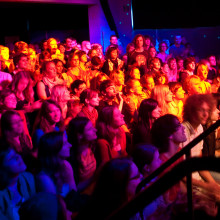
26:33 - Festival of the Spoken Nerd
Festival of the Spoken Nerd
with Helen Arney, Festival of the Spoken Nerd
Obviously science is no laughing matter, or is it? Comedy troup Festival of the Spoken Nerd are running a best-of show at Soho Theatre in London, and all of their comedy is about ... science. Kat Arney has been hearing all about it...
It’s our wedding anniversary next week.
My gift for you is carefully chosen
It’s perfect for the couple who have everything.
I’m getting us both cryogenically frozen…
Helen - Hello. I’m Helen Arney. I’m one third of Festival of the Spoken Nerd. We are three comedians who all have a background in science and have decided that what the world needs more than anything else is a comedy show that is not taking the ‘mick’ out of science. That is not the same old science gags about two atoms walking into a bar.... and all of that stuff, and this is a comedy show that is science. We do experiments, I do songs that have been peer reviewed. Steve does crazy things that he’s been around the world investigating. Matt does stand up maths - Matt Parker that is, the UKs premier/only stand-up mathematician.
Matt - Alright. Give me a cheer if you are ready to plot some parabolic functions?
Audience - Woooh!
Helen - And between the the three of us we’ve created this thing that we did for our own pleasure really to start with, that was trying to make comedy that felt like real science...
Steve - Ladies and Gentlemen - 230 volts and a pickle!
Kat - Is there any science that you apply to your gigs? Are there any scientific experiments or thinking about things scientifically when it comes to trying to make people laugh?
Helen - I do think there are some parallels between science and comedy. Because when you’re a scientist you have a hypothesis, you think that an experiment is going to produce a certain result, and you have to be open to the idea that that result isn’t going to go the way you think it is. When you’re a comedian, your hypothesis is: I think this joke is funny, therefore this audience will laugh at this joke. And you take it out there, you say it on stage, they don’t laugh. You have to accept that your hypothesis was wrong. The evidence says this audience does not find that joke funny.
Kat - Null laughter hypothesis?
Helen - You have to accept that. And you iterate, you change how you do it. Maybe there was something wrong with your method - maybe how you delivered it was wrong. Maybe you forgot one of the variables.
Kat - And of course, the secret of comedy is.... Timing.
Helen - Oh yes, timing. And science as well.
[singing]
And you’re my man
And I want you to understand
How it feels when I hold your hand
So I’ll draw a venn diagram...
We’re doing a song that I wrote years ago - it’s called “Statistically I Love You” and it’s a mathematically accurate love song. I try and do this song very beautifully. Very seriously for the audience, and Matt and Steve decide that it’s not interesting enough on it’s own, so Steve decides to do powerpoint slides to go with it. Matt decides that that’s not good enough and he brings out an overhead projector... to do slides on as well. And the whole thing becomes this like improvised comedy jazz with slides.
I’ve always wanted to be in a band right. I never thought that band would contain me, a ukulele, powerpoint, and a slide projector. But it does… and it works!
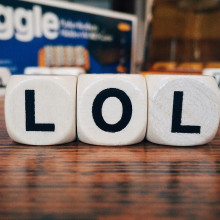
31:09 - Why do we laugh?
Why do we laugh?
with Professor Sophie Scott, University College London
Laughter isn’t just found in comedy shows - people are laughing their socks off all the time. But what’s the point? When, and why, did our species start laughing, and is it unique to us? Chris Smith spoke to neuroscientist Professor Sophie Scott, from University College London.
Sophie - It’s a very interesting behaviour because if you ask human adults about it it’s something we like and we’ll talk about. But we’ll say that we laugh at jokes and comedy and humour but if you actually watch us, and this was done very nicely by Robert Provine, what you find is it’s a completely social behaviour, it’s something we do when we’re with other people. Most of laughter occurs during conversations with other people and, even then, we’re hardly ever laughing at jokes. We’re laughing to show we understand people and we agree with them, or we know them, we like them, we’re part of the same group as them. So we’re doing a huge amount of social aspects of our interaction - we’re actually managing with laughter.
Chris - But when I’m actually laughing Sophie, whats going on physiologically - what’s my body doing because it’s quite a distinct thing, isn’t it laughter? Everyone can recognise what a laugh is.
Sophie - Exactly. And it’s actually a very, very basic way of making a sound. When you start laughing, what happens is the intercostal muscles in the diaphragm, which I’m using right now to produce a very finely controlled flow of air out through my larynx and that’s how we all talk. Instead of doing that these muscles start to do very large single contractions and that just squeezes air out of you, and you squeeze the air out under very high pressures. So you start making sounds you wouldn’t normally make but each one of those individual ha, ha, ha sounds, literally, is air just being pushed from you. You could achieve the same by jumping up and down on someone’s rib cage. It’s very, very basic and it’s probably why babies can do it from a very early age. There’s nothing complex to it at all.
Chris - Is sounds very similar to coughing.
Sophie - It is extremely similar to coughing and also, of course, to crying, weeping. So it’s a very basic, very uncomplex way of making a sound. Something we don’t understand is, if there is a competition between talking and breathing and laughing, laughter will win. There’s something about the motor control of it that overwhelms everything else, and that’s why you can tell if someone’s talking and they start laughing, it’s absolutely unmissable in their voice.
Chris - Now when do we think that this behaviour first evolved?
Sophie - Throughout history, humans have been very prone to think that we are the only animals that laugh. Nietzsche thought only man laughed I think; I think Aristotle though only man laughed but, actually, you find it in other animals. It’s very easily observed in other apes. So gorillas and chimpanzees, orang utans they laugh and it’s very like human laughter - it looks and sound like human laughter. But it’s also been described in rats. So it’s possible that there is more laughter out there and I think, at the moment it’s fair to say, no-ones really looking for it. But it would be very interesting to know about exactly how you can trace its appearance in the evolution of mammals, because that does seem to be what it is. It’s a mammalian behaviour which is not something associated in a straightforward way with humour because chimpanzees and rats aren’t laughing at jokes. They’re laughing at interactions and they’re laughing at things like being tickled. So it seems to have a much more basic role for mammals and, potentially, there’s a lot more of it out there.
Chris - Is that why they’re called howler monkeys?
Sophie - Ohhh - possibly!
Chris - Now when you say it’s not just us, there are these other mammals that laugh - how do we know they’re laughing and what do they laugh at?
Sophie - The main thing that they seem to laugh at is very common with humans. It’s tickling and I know my colleague, Caspar Addyman, is going to talk more about this in humans, but tickling is very common across animals that laugh. Tickling is what gets rats laughing, orang utans laughing, gorillas and humans. But it’s also play, and all mammals play when they’re infants. It’s very important mammalian behaviour and Panksepp who’s done some very beautiful work on rat laughter; he first noticed this sound that, actually, when rats were playing with each other and he wondered if that was laughter and started tickling the rats to see if it make the same sound. But he says, at it’s heart, laughter is an invitation to play - it’s kind of putting the interaction onto a playful, unthreatening, enjoyable basis. And that’s a very, very useful way of managing interactions for animals and mammals are very often highly social so it matters to them.
Chris - Now what about looking at our own species for a minute then - what about the ubiquity of laughter. Do we all do it?
Sophie - We do all do it. So laughters found, in terms of the universality of it, seems to be a basic human emotion. You don’t find cultures where people never laugh. You find cultures where people laugh more and laugh less. There are cultures where public laughter can be quite impolite, but people will still laugh in private and they’ll still laugh in other situations. So it seems to be, as far as we can see, a genuinely universal emotion, though it can be socially quite variable to any one extent, with any one culture, how appropriate it is to laugh on a minute to minute basis.
Chris - Is the ability to have a sense of humour universally represented amongst humans and also the ability to laugh in this way amongst mammals?
Sophie - One thing I would be clear is that you do need to distinguish humour from laughter because, as far as we know all humans, to one extent or another, will show laughter. Laugher is a very, very common behaviour although with a proviso it can go wrong in some psychiatric conditions. But that’s not the same as everybody having the same kind or use of humour, and humour varies really widely even within a culture. Based on how old you are you’ll find different stuff funny and all sorts of other stuff influences that. So what you find is that humour is incredibly variable and complex and plastic, and then our behaviour to it, which is often laughter, can actually be very, very familiar.
Chris - so is there a sort of humour centre in the brain which that can then activate or be activated by things like the tickling centre, so if I tickle you and you laugh, that will also elicit the same reactions if I tickle you with a joke and you laugh?
Sophie - It seems not to. So people have put people into scanners and they’ve tickled them and what they found is that tickling laughter is associated with increased activation in the hypothalamus, which is a tiny part of the brain involved in hormone release. In contrast, if you scan people while they’re listening to jokes, what you essentially get is the language system working away to help you understand what the jokes are, so they do seem to be quite distinct. We’ve definitely got a hallmark of brain activation that seems to be associated with tickling and it’s different from understanding a joke.
Chris - And have you got a joke for us to finish on Sophie?
Sophie - What’s green and invisible?
Chris - I don’t know - what is green and invisible?
Sophie - This lettuce. Perhaps not the best for radio!
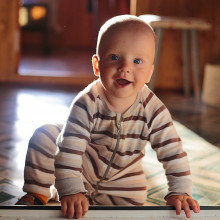
Laughing babies
with Dr Caspar Addyman, Goldsmiths, University of London
When do people first start laughing, and what do we first find funny? Caspar Addyman is a developmental psychologist at Goldsmiths, University of London where he’s been investigating baby laughter, as he explained to Georgia Mills.
Caspar - The first thing I noticed is that babies seem to laugh more than us and because they were doing it, it seemed an important thing to look into. The starting point for doing it was just by asking parents. We did a big survey all round the world about the things that made their babies laugh and the situations and the people.
Georgia - Have you found out what babies find funny?
Caspar - Well, it completely echoes what Sophie was just saying really. The thing that makes babies laugh is people. Tickling, but it has to be tickling done by someone that is really trusted and close to you. But then, beyond that, everything that makes a baby laugh is a social interaction of some kind.
Georgia - Okay. So the tickling thing, that’s funny isn’t it because you laugh, but when you’re being tickled it’s also kind of quite hellish in a way? So there’s a strange link between the sort of laughing and also being in a bit of peril.
Caspar - Yes. I think that’s part of why it only works with someone that you know very well. There’s a great bit in one of Darwin’s books where he observes that little children don’t like being tickled by strange men with beards. And yet, they seem to find it great when it’s their parents doing it.
Georgia - If I wanted to do stand up for babies, what would the most funny thing I could do be?
Caspar - I wouldn’t try getting a whole room of babies and try to make them all laugh! Actually, I’ve worked with some people in theatre and they say the best way to do that is to drop things. Babies like it when adults make mistakes. But if you’ve got a one-on-one situation with a baby and you want to make it laugh, my main advice is actually to take it as seriously as you possibly can. Really tune in to the baby’s own tempo and when they notice that you’re actually really attending to them, they going to be delighted and you’ll get big smiles. And then, once you spot the thing in the interaction that really catches their eye, then you’ll get laughs.
Georgia - Okay. So when you’re playing peek-a-boo or something with a baby and they’re laughing, why are they laughing at you? What’s the point, I guess, from an evolutionary point of view for a baby to laugh at you?
Caspar - Well, I guess, there are two parts to it; one is that they’re just very happy. They are enjoying themselves and it’s a indication of that, it’s a measure of pleasure. But it’s also a social signal to you, as Sophie was saying, an invitation to play. It’s an invitation to keep going with this. In some ways, you could think of laughter as the opposite of crying. A crying baby is telling you - please stop this. A laughing baby is saying - no, no, carry on, this is delightful.
Georgia - So it’s kind of a reward for you that you’re spending this time giving them attention? Were there any other sort of discrepancies between what babies found funny compared to older children and adults?
Caspar - I think, not unexpectedly, what babies find funny is the foundation of things that come later. It’s quite slow to build up and so jokes don’t really start to be recognisably as jokes until really quite late. Children from about two or three years old start to understand situations where you use the wrong words - look at the dog when you’re pointing to a cat. And that’s not really a joke as yet but they find it funny because it’s wrong and they recognise it wrong. But it’s only till about six or seven that they actually really understand what the jokes are and are not just laughing because everybody else round the table is laughing.
Georgia - Do we know when babies actually try and be funny back and make mummy and daddy laugh?
Caspar - That is a lot earlier. So that, I’d typically say is around about a year old. The classic mistake parents make - baby blows a big raspberry into their food, parents laugh and they find this hilarious. Baby realises this a way to make the parents laugh and keeps repeating this action again, and again, and again.
Georgia - Oh no...
Caspar - So they’ve learnt that oh, I can make you laugh by doing this.

The joking robot
with Professor Graeme Ritchie, University of Aberdeen
What kind of tree is nauseated?
A sick-amore!
Not bad for a cracker joke, but impressively, this was actually written by a computer programme! Its creator, Professor Graeme Ritchie spoke to Chris Smith about the challenges involved in getting computers to understand jokes.
Graeme - We started this in the early ‘90s and, at that stage, artificial intelligence was trying to model virtually every aspect of human behaviour, except for some of the more emotional and creative facets of human life. Nobody had looked at humour or jokes and we figured that AI was a good way to model human behaviour and to understand what was going on.
So we started at what we thought was the shallow end with these very simple punning jokes, the kind of things you’ve just been listening to, because we thought they had some structure to them, we could see some simple patterns in them, and that was just a first step along the road. So we weren’t really trying to model a sense of humour, which is a much more subtle thing, we were just trying to figure out what the shape of jokes they are and how we can write rules that will describe those jokes. And we say this as one step on a very long road towards getting a better understanding of how jokes work.
Chris - They are actually quite clever in the sense that when you see them like :
What do you call an enemy image? That’s another one of your computer’s jokes.
A foe-to.
I mean, they are quite clever but they’re not that funny. What theories do we have of what makes something funny?
Graeme - There's a bit of a lack on the theoretical side. People have been writing about humour for centuries and it seems, on the face of it, we have quite a lot of theories of humour - several. But when you examine them very closely, they’re not what an actual scientist would call a theory, they tend to be very broad opinions about things that go on in humour.
Chris - Can you reverse the equation Graeme? And you’ve got a computer programme that will generate things like puns that have a potential to make us laugh. Didn’t work on Sophie, but you know, we’re working on that. Can you turn it round and feed something into your computer programme and it would know if I was joking? Because, if said certain things to you, certain word orders or certain manner of speaking, you’d know I was punning at you. Can your computer do that?
Graeme - Not at the moment. And that’s actually quite a difficult problem because the whole range of what you could, in principle, feed in is so vast that it’s quite a challenging task to figure out whether it’s a joke or not because there could be so many different ways of making a joke. When you’re generating, you have the data under control. You’re experimenting with exactly the area of humour that you want to look at and that’s all you’re generating. So you can narrow down the focus to a particular genre of humour. When you’re accepting input then it's much more difficult. It would just be an act of programming to write something which takes the jokes of the kind we generate and recognises exactly those kind of jokes and no other. We could do that but it wouldn’t be very interesting because all we would be doing is just reversing the process. And if you fed it anything other than exactly that kind of joke, it would just say no, even if was a very funny joke of some other kind.
Chris - It’s pretty important, isn’t it? Because if we seek to use these sorts of systems in the future engaging with people whether it’s the ATM machine for you getting money out or a telephone answer system or something. People are human and they do have humour and humour is a very important part of our social interactions. That’s what Sophie was saying. And if we don’t have systems that are capable of understanding and modeling it then we’re not going to enjoy the engagement with models like you're creating.
Graeme - Well, that’s true and a lot of people have argued that if we’re going to have avatars on our computer system, or our phones, or our tablets that interact with us in avery natural lifelike way, they’re going to have to have the equivalent of a sense of humour because they’re going to have to pick up if the user is being lighthearted or just making a joke. They’re going to have to recognise that. And there’s also an argument that says that maybe the intelligent agent on the device should maybe lighten up it’s own interactions with the occasional joke but that’s a bit more risky.

Laughter: the best medicine?
with Zoe Harris, Laughter Yoga Instructor
While there is no Universal theory of what makes something funny, we do know it's good to have a giggle when you can, so the Naked Scientists were treated to a laughter yoga session from teacher Zoe Harris. First, Georgia Mills heard about the benefits from neuroscientist Sophie Scott.
Sophie - It definitely de-stresses you. So what happens when you’ve been laughing is you get a bit of an endorphin kick because you’ve been doing some exercise. You also get a reduction in adrenaline so you become less stressed. But also, over a longer timescale you get a decrease in cortisol release so that’s a longer time hallmark of becoming just less stressed generally. So it definitely is something that it doesn’t just feel good, you are actually more relaxed and less stressed out at the end of it.
Georgia - Well, a type of yoga relies on this very idea- you force yourself to L O L, to get some of these benefits. Earlier in the week The Naked Scientist team had a little outing to their first ever laughter yoga session…
Zoe - Hello. My name is Zoe Harris and I teach laughter yoga. Laughter yoga can basically be boiled down to a series of funny exercises. So think of improv, think of acting in a foolish way, repetitive exercises that perhaps you don’t find funny at first, but you soon will.
What the laughter is supposed to do is it has two effects on the body. So physically, you’re inhaling a lot more oxygen, you’re using more of your lung capacity, so it’s oxygenating the blood, it’s helping you feel more energised. It has a real positive effect on the body in terms of psychological benefits as well because the process of laughing helps reduce the stress hormones in the body so it’s helping you feel less conscious, less anxious, more confident about yourself. And physically also, the process of laughing from the deep belly and the diaphragm so you’re exercising muscles internally, but especially your heart muscle as well. And it is said that your one minute of laughter is worth ten minutes on the rowing machine for your heart, so that’s good news.
It’s literally tricking your brain into doing it. So when you start a lot of exercises you think oh, this is quite embarrassing, I don’t want to do it. That you laugh anywhere, your body starts laughing so you just fake it till you make it really.
Tom - Yeah, it was interesting. It was interesting how you switched from sort of artificial laughter to somebody starting to crack and then it just spreads around the room. You do really feel it in your stomach afterwards and you’ve definitely been laughing.
Graihagh - The highlight for me was the Hawaii - what was it Aloha,ha ha ha ha. Like that. And the bees - I quite liked the bees. I think I’d do that at work if I was getting stressed about something.
Dotty- I thought the bees were really good as well when you hum like a bee and close your ears. It was quite odd but I do feel a lot better than when I started. I’ve maybe gone from a pretty low four out of ten up to a kind of a seven, so that says something.
Lucille- It was really good. There was a bit where we were looking silly but… a really nice time and with nice people.
Megan - I’m definitely going to practice it when I get home and freak out my house mates.
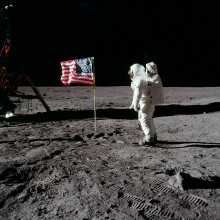
52:46 - What would happen if I peed on the moon?
What would happen if I peed on the moon?
Dr Chris Messenger from the University of Glasgow was on hand to help Tom Crawford with Michael's question.
Chris - The answer depends on the environment that you are in. If the astronaut is inside a pressurised and temperature controlled environment then the only difference between the moon and the Earth would be the gravity, which on the moon is 16% of the Earth’s. This gives the rather boring answer that the pee would simply follow a “straighter” arc, or, it would travel about 2 and a half times further than on earth depending on the trajectory.
Tom - So when I pee on earth, what shape is the arc that forms?
Chris - In a uniform gravitational field like on the surface of large objects such as the Earth and moon, the trajectory of an object (in our case each unit of pee) follows what’s known as a parabolic curve - sort of a u-shape. On Earth air resistance can cause objects to deviate from perfect parabolas but on the moon, since there’s essentially no atmosphere, the pee will follow a very accurate parabola. In fact, if you watch video of the lunar rover that the Apollo astronauts drove around the moon, you can see the dust being thrown into the air and following these exact curves.
Tom - Right, let’s assume we’re on the moon, or even better Neil Armstrong is there, back in 1969, and he needs to boldly go. Perhaps we can even ‘livestream’ the event as suggested by Stephen on Facebook… What would actually happen?
Chris - If we’re talking about somehow being able to pee directly out of your spacesuit while standing on the moon then the extremely low atmospheric pressure on the moon would immediately boil the pee. The steam would then fall to the floor under the moon’s weak gravity because there’s no atmosphere to carry the steam.
Tom - Hang on, I thought the moon was cold, why are things starting to boil?
Chris - There are number of different states that matter can be in, with the basic three being solid, liquid, and gas. The particular state that a particular substance is in depends only on the temperature and pressure. If you think about water (the main component of your pee) we know, for example, that when you climb a mountain, the air pressure drops and the boiling point of water starts to drop, so at the top of Mount Everest you can make a cup of tea at 71 degrees celsius. In the peeing on the moon scenario, the pee is at body temperature, around 37 degrees celcius and the pressure in the spacesuit will hopefully be at earth’s atmospheric pressure. As soon as it enters the moon environment the pressure drops by a factor of more than a thousand billion. The pee suddenly finds itself way above it’s own boiling point and has to immediately boil into steam.
Tom - If you thought the idea of peeing out steam sounds bad, it gets worse...
Chris - The steam molecules are able to react to the change in temperature between the spacesuit and the moon environment. Depending on the position of the sun in the lunar sky the temperature on the moon surface will range from -170 degrees Celsius to 120 degrees Celsius but since the pressure is so low, the freezing temperature of the pee also changes to a similar range, so in some circumstances the steam molecules will freeze into water ice crystals and you could get yellowish snow that falls to the ground under gravity.










Comments
"In the movie War Games, they
"In the movie War Games, they hack the Pentagon using an Atari."
This was a frustrating comment. They hacked the pentagon using an IMSAI. That's an Intel 8080 based machine which had less power than most Atari machines your listeners might know. Furthermore, the IMSAI was only used as a terminal.
And this is not a mistake. It's quite a reasonable way to get onto a system. Back-doors are not common (one assumes/hopes) and are much less common now that more people look at and understand the source code of your programs, but they were a known security issue at the time and we _still_ see them, for example, in consumer-grade routers. Wargames should be applauded for getting this right.
And the IMSAI is a beautiful piece of history and looks nothing like any Atari. Really. NOTHING.
(The system that read the text from the screen was a Votrax Type-and-Talk appliance, which actually existed and one could buy. Note that they created their own audio for the text reading, because the Votrax didn't sound that great. But they had the appliance and showed it being turned on to get the speech. The writers of Wargames understood computing quite well. Way better than your commenter.)
If you want to poke at the accuracy of Wargames, while you could attack the fact that the WOPR computer is sentient or uses language, that's the core sci-fi of the film so that's not fair. A better attack on Wargames is the way in which the final numbers of the launch code take no longer to decrypt than the first ones. Ask any computer security person about the way in which WOPR breaks the launch codes -- you don't figure out digits one at a time left to right, and if generally if you mangle up some scenario where you do, you could reasonably expect the decryption to go faster as the number of possibles dwindled.
Add a comment